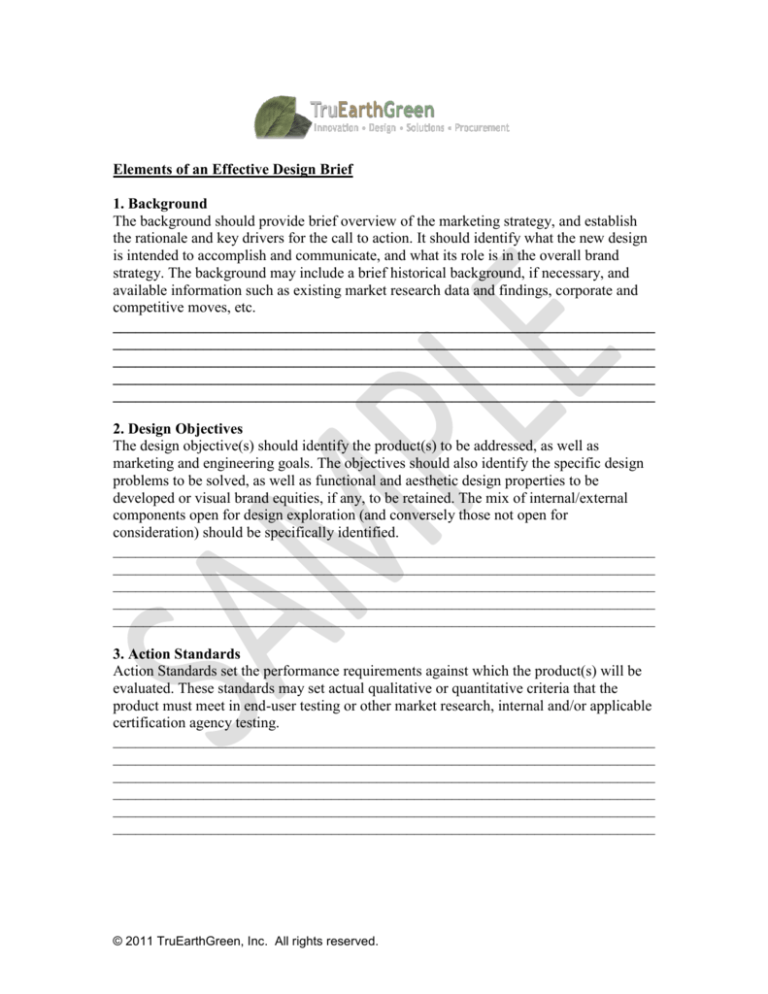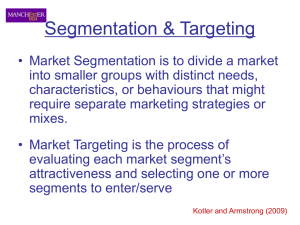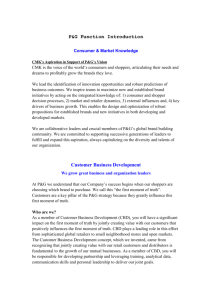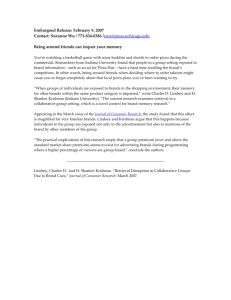
Elements of an Effective Design Brief
1. Background
The background should provide brief overview of the marketing strategy, and establish
the rationale and key drivers for the call to action. It should identify what the new design
is intended to accomplish and communicate, and what its role is in the overall brand
strategy. The background may include a brief historical background, if necessary, and
available information such as existing market research data and findings, corporate and
competitive moves, etc.
________________________________________________________________________
________________________________________________________________________
________________________________________________________________________
________________________________________________________________________
________________________________________________________________________
2. Design Objectives
The design objective(s) should identify the product(s) to be addressed, as well as
marketing and engineering goals. The objectives should also identify the specific design
problems to be solved, as well as functional and aesthetic design properties to be
developed or visual brand equities, if any, to be retained. The mix of internal/external
components open for design exploration (and conversely those not open for
consideration) should be specifically identified.
________________________________________________________________________
________________________________________________________________________
________________________________________________________________________
________________________________________________________________________
________________________________________________________________________
3. Action Standards
Action Standards set the performance requirements against which the product(s) will be
evaluated. These standards may set actual qualitative or quantitative criteria that the
product must meet in end-user testing or other market research, internal and/or applicable
certification agency testing.
________________________________________________________________________
________________________________________________________________________
________________________________________________________________________
________________________________________________________________________
________________________________________________________________________
________________________________________________________________________
© 2011 TruEarthGreen, Inc. All rights reserved.
4. Market Opportunity
As an option, a review of the market situation or standing may be included. The
marketplace context and strategic marketing objectives can be identified, and information
such as expected brand and competitive market share can be included.
________________________________________________________________________
________________________________________________________________________
________________________________________________________________________
________________________________________________________________________
________________________________________________________________________
5. Target Consumer
Include any available information regarding the target consumer. This can be comprised
of demographic profiles, purchase drivers, end-user research etc. – in fact any available
information regarding the target consumer.
________________________________________________________________________
________________________________________________________________________
________________________________________________________________________
________________________________________________________________________
________________________________________________________________________
6. End User Requirements
It is important to include vital consumer issues and needs with respect to the product such
as:
Ergonomics: ease of handling, dispensing, installing, opening, closing, reclosing
or resealing,
Cognitive or other human factors: ease of understanding features/use of the
structure, etc.
Safety issues
Convenience criteria such as storage, cleaning, etc.
Environmental impact, if applicable
________________________________________________________________________
________________________________________________________________________
________________________________________________________________________
________________________________________________________________________
________________________________________________________________________
7. Brand Story/Brand Distinction
As an option, relevant background information can be provided to further develop the
brand differentiation against both internal and competitive brands. For example, a
description may include a brand story or claims (i.e. new technology or alternative
materials, etc.) that may provide for brand uniqueness, authority, credibility, etc. to
strengthen market position and give direction for product design.
________________________________________________________________________
________________________________________________________________________
________________________________________________________________________
© 2011 TruEarthGreen, Inc. All rights reserved.
________________________________________________________________________
_______________________________________________________________________
8. Competitive Brands & Benchmarking
It is important to understand the brand in relation to competitive brands. All available and
relative competitive information should be included, such as all targeted brands,
respective market share, imagery, product attributes, and recent competitive moves.
________________________________________________________________________
________________________________________________________________________
________________________________________________________________________
________________________________________________________________________
________________________________________________________________________
________________________________________________________________________
9. Retail Distribution & Environment
Strategy for placement by distribution channel(s) should be presented, organized by order
of importance and by key outlet chains, as appropriate.
________________________________________________________________________
________________________________________________________________________
________________________________________________________________________
________________________________________________________________________
________________________________________________________________________
________________________________________________________________________
10. Trade/Customer Requirements
If there are specific presentation considerations for the product at retail, this should be
included in the brief. Examples of these requirements include:
Shelf-space allocation or constraints
Merchandising requirements & opportunities
Pilferage/damage resistance
________________________________________________________________________
________________________________________________________________________
________________________________________________________________________
________________________________________________________________________
________________________________________________________________________
________________________________________________________________________
11. Production Methods/Requirements
Specific production requirements should be detailed in the brief. These criteria can
include:
Specific components to be developed
Stock or standard components available or to be used
Criteria (including issues and limitations and relative importance) of product
shape, size, materials, color, finishes, production methods, etc.
Product delivery or capacity, specific sizes, volumetrics, etc.
© 2011 TruEarthGreen, Inc. All rights reserved.
Shelf-life, product characteristics over time, product/packaging compatibility
issues, etc.
Method of applying surface graphics
Unit costs- current and targeted
Production constraints such as filling line restrictions, warehousing, and
distribution
Vendor preferences with respect to manufacturing and distribution
________________________________________________________________________
________________________________________________________________________
________________________________________________________________________
________________________________________________________________________
________________________________________________________________________
12. Mandated Information
Any and all legal and technical constraints should be included.
________________________________________________________________________
________________________________________________________________________
________________________________________________________________________
________________________________________________________________________
________________________________________________________________________
13. Timing
Timing expectations, limitations or demands should be included in terms of target
deliverable dates, ship-to-trade, and key development events (presentations, meetings,
research, etc.)
________________________________________________________________________
________________________________________________________________________
________________________________________________________________________
________________________________________________________________________
________________________________________________________________________
© 2011 TruEarthGreen, Inc. All rights reserved.












